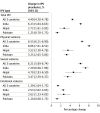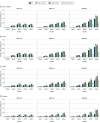Association of Ambient Temperature With the Prevalence of Intimate Partner Violence Among Partnered Women in Low- and Middle-Income South Asian Countries
- PMID: 37379013
- PMCID: PMC10308303
- DOI: 10.1001/jamapsychiatry.2023.1958
Association of Ambient Temperature With the Prevalence of Intimate Partner Violence Among Partnered Women in Low- and Middle-Income South Asian Countries
Abstract
Importance: Intimate partner violence (IPV), including physical, sexual, and emotional violence, constitutes a critical public health problem, particularly in low- and middle-income countries. While climate change could escalate violent events, data quantifying its possible association with IPV are scant.
Objective: To evaluate the association of ambient temperature with the prevalence of IPV among partnered women in low- and middle-income countries in South Asia, and to estimate the association of future climate warming with IPV.
Design, setting, and participants: This cross-sectional study used data from the Demographic and Health Survey and included 194 871 ever-partnered women aged 15 to 49 years from 3 South Asian countries (India, Nepal, and Pakistan). The study applied the mixed-effect multivariable logistic regression model to investigate the association of ambient temperature with IPV prevalence. The study further modeled the change in IPV prevalence under various future climate change scenarios. The data included in the analyses were collected from October 1, 2010, to April 30, 2018, and the current analyses were performed from January 2, 2022, to July 11, 2022.
Exposure: Annual ambient temperature exposure for each woman, estimated based on an atmospheric reanalysis model of the global climate.
Main outcomes and measures: The prevalence of IPV and its types (physical, sexual, and emotional violence) were assessed based on self-reported questionnaires from October 1, 2010, to April 30, 2018, and the changes in the prevalence with climate changes were estimated through the 2090s.
Results: The study included 194 871 ever-partnered women aged 15 to 49 years (mean [SD] age, 35.4 [7.6] years; overall IPV prevalence, 27.0%) from 3 South Asian countries. The prevalence of physical violence was highest (23.0%), followed by emotional (12.5%), and sexual violence (9.5%). The annual temperature ranges were mostly between 20 °C and 30 °C. A significant association was found between high ambient temperature and the prevalence of IPV against women, with each 1 °C increase in the annual mean temperature associated with a mean increase in IPV prevalence of 4.49% (95% CI, 4.20%-4.78%). According to the study's projections under the unlimited emissions scenarios (SSPs [shared socioeconomic pathways], as defined by the Intergovernmental Panel on Climate Change] 5-8.5), IPV prevalence would increase by 21.0% by the end of the 21st century, while it would only moderately increase under increasingly stricter scenarios (SSP2-4.5 [9.8%] and SSP1-2.6 [5.8%]). In addition, the projected increases in the prevalence of physical (28.3%) and sexual (26.1%) violence were greater than that of emotional violence (8.9%). In the 2090s, India was estimated to experience the highest IPV prevalence increase (23.5%) among the 3 countries, compared with Nepal (14.8%) and Pakistan (5.9%).
Conclusions and relevance: This cross-sectional, multicountry study provides ample epidemiological evidence to support that high ambient temperature may be associated with the risk of IPV against women. These findings highlight the vulnerabilities and inequalities of women experiencing IPV in low- and middle-income countries in the context of global climate warming.
Conflict of interest statement
Figures





Similar articles
-
Maternal exposure to intimate partner violence and breastfeeding practices in 51 low-income and middle-income countries: A population-based cross-sectional study.PLoS Med. 2019 Oct 1;16(10):e1002921. doi: 10.1371/journal.pmed.1002921. eCollection 2019 Oct. PLoS Med. 2019. PMID: 31574100 Free PMC article.
-
Intimate partner violence against married and cohabiting women in sub-Saharan Africa: does sexual autonomy matter?Reprod Health. 2022 Mar 28;19(1):79. doi: 10.1186/s12978-022-01382-1. Reprod Health. 2022. PMID: 35346246 Free PMC article.
-
Association between maternal experiences of intimate partner violence and child stunting: a secondary analysis of the Demographic Health Surveys of four South Asian countries.BMJ Open. 2024 Jan 19;14(1):e071882. doi: 10.1136/bmjopen-2023-071882. BMJ Open. 2024. PMID: 38245010 Free PMC article.
-
Prevalence of intimate partner violence against women in the Arab world: a systematic review.BMC Int Health Hum Rights. 2019 Oct 22;19(1):29. doi: 10.1186/s12914-019-0215-5. BMC Int Health Hum Rights. 2019. PMID: 31640716 Free PMC article.
-
Assessment of Microfinance Interventions and Intimate Partner Violence: A Systematic Review and Meta-analysis.JAMA Netw Open. 2023 Jan 3;6(1):e2253552. doi: 10.1001/jamanetworkopen.2022.53552. JAMA Netw Open. 2023. PMID: 36705918
Cited by
-
The connection between climate change and perinatal mental health.Front Psychiatry. 2025 Jan 21;15:1515895. doi: 10.3389/fpsyt.2024.1515895. eCollection 2024. Front Psychiatry. 2025. PMID: 39906678 Free PMC article.
-
Temperature, Crime, and Violence: A Systematic Review and Meta-Analysis.Environ Health Perspect. 2024 Oct;132(10):106001. doi: 10.1289/EHP14300. Epub 2024 Oct 15. Environ Health Perspect. 2024. PMID: 39404825 Free PMC article.
-
Mental health amid climate crisis: A narrative review.Indian J Psychiatry. 2024 Nov;66(11):987-996. doi: 10.4103/indianjpsychiatry.indianjpsychiatry_526_24. Epub 2024 Nov 16. Indian J Psychiatry. 2024. PMID: 39790355 Free PMC article. Review.
-
Hot Weather and Violence Against Women: A Global Scoping Review.Int J Environ Res Public Health. 2025 Jul 3;22(7):1069. doi: 10.3390/ijerph22071069. Int J Environ Res Public Health. 2025. PMID: 40724135 Free PMC article. Review.
-
Temperature, violent crime, climate change, and vulnerability factors in 44 United States cities.Environ Int. 2025 Jan;195:109246. doi: 10.1016/j.envint.2024.109246. Epub 2024 Dec 30. Environ Int. 2025. PMID: 39742829 Free PMC article.
References
-
- United Nations Department of Economic and Social Affairs. Sustainable Development Goals 5: achieve gender equality and empower all women and girls. Updated 2022. Accessed May 2023. https://sdgs.un.org/goals/goal5
-
- Coll CVN, Ewerling F, García-Moreno C, Hellwig F, Barros AJD. Intimate partner violence in 46 low-income and middle-income countries: an appraisal of the most vulnerable groups of women using national health surveys. BMJ Glob Health. 2020;5(1):e002208. doi:10.1136/bmjgh-2019-002208 - DOI - PMC - PubMed
-
- Ellsberg M, Jansen HA, Heise L, Watts CH, Garcia-Moreno C; WHO Multi-country Study on Women’s Health and Domestic Violence against Women Study Team . Intimate partner violence and women’s physical and mental health in the WHO multi-country study on women’s health and domestic violence: an observational study. Lancet. 2008;371(9619):1165-1172. doi:10.1016/S0140-6736(08)60522-X - DOI - PubMed
Publication types
MeSH terms
Grants and funding
LinkOut - more resources
Full Text Sources
Medical
Miscellaneous

